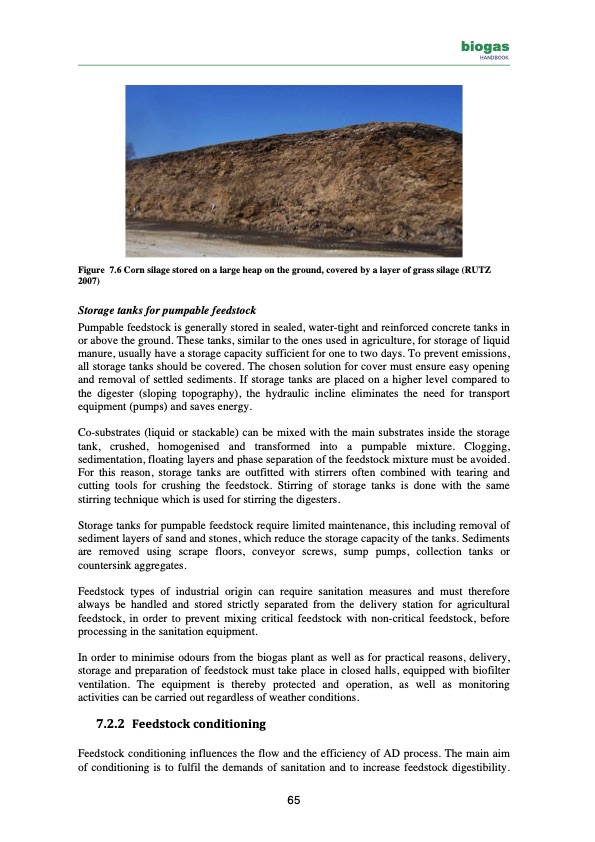
PDF Publication Title:
Text from PDF Page: 065
biogas HANDBOOK Figure 7.6 Corn silage stored on a large heap on the ground, covered by a layer of grass silage (RUTZ 2007) Storage tanks for pumpable feedstock Pumpable feedstock is generally stored in sealed, water-tight and reinforced concrete tanks in or above the ground. These tanks, similar to the ones used in agriculture, for storage of liquid manure, usually have a storage capacity sufficient for one to two days. To prevent emissions, all storage tanks should be covered. The chosen solution for cover must ensure easy opening and removal of settled sediments. If storage tanks are placed on a higher level compared to the digester (sloping topography), the hydraulic incline eliminates the need for transport equipment (pumps) and saves energy. Co-substrates (liquid or stackable) can be mixed with the main substrates inside the storage tank, crushed, homogenised and transformed into a pumpable mixture. Clogging, sedimentation, floating layers and phase separation of the feedstock mixture must be avoided. For this reason, storage tanks are outfitted with stirrers often combined with tearing and cutting tools for crushing the feedstock. Stirring of storage tanks is done with the same stirring technique which is used for stirring the digesters. Storage tanks for pumpable feedstock require limited maintenance, this including removal of sediment layers of sand and stones, which reduce the storage capacity of the tanks. Sediments are removed using scrape floors, conveyor screws, sump pumps, collection tanks or countersink aggregates. Feedstock types of industrial origin can require sanitation measures and must therefore always be handled and stored strictly separated from the delivery station for agricultural feedstock, in order to prevent mixing critical feedstock with non-critical feedstock, before processing in the sanitation equipment. In order to minimise odours from the biogas plant as well as for practical reasons, delivery, storage and preparation of feedstock must take place in closed halls, equipped with biofilter ventilation. The equipment is thereby protected and operation, as well as monitoring activities can be carried out regardless of weather conditions. 7.2.2 Feedstockconditioning Feedstock conditioning influences the flow and the efficiency of AD process. The main aim of conditioning is to fulfil the demands of sanitation and to increase feedstock digestibility. 65PDF Image | biogas HANDBOOK

PDF Search Title:
biogas HANDBOOKOriginal File Name Searched:
BiogasHandbook.pdfDIY PDF Search: Google It | Yahoo | Bing
Capstone Turbine and Microturbine: Capstone microturbines used and new surplus for sale listing More Info
Consulting and Strategy Services: Need help with Capstone Turbine, sizing systems, applications, or renewable energy strategy, we are here to assist More Info
Container Lumber Dry Kiln: Since 1991 developing and innovating dry kilns using standard shipping containers More Info
Supercritical CO2 Lumber Dry Kiln: Compact fast drying in 3 days or less for small amounts of wood and lumber drying More Info
BitCoin Mining: Bitcoin Mining and Cryptocurrency... More Info
Publications: Capstone Turbine publications for microturbine and distributed energy More Info
FileMaker Software for Renewable Energy Developing database software for the renewable energy industry More Info
CO2 Gas to Liquids On-Demand Production Cart Developing a supercritical CO2 to alcohol on-demand production system (via Nafion reverse fuel cell) More Info
Stranded Gas for low cost power Bitcoin Mining Using stranded gas for generators may provide breakthrough low power costs for cryptocurrency miners. More Info
| CONTACT TEL: 608-238-6001 Email: greg@globalmicroturbine.com | RSS | AMP |